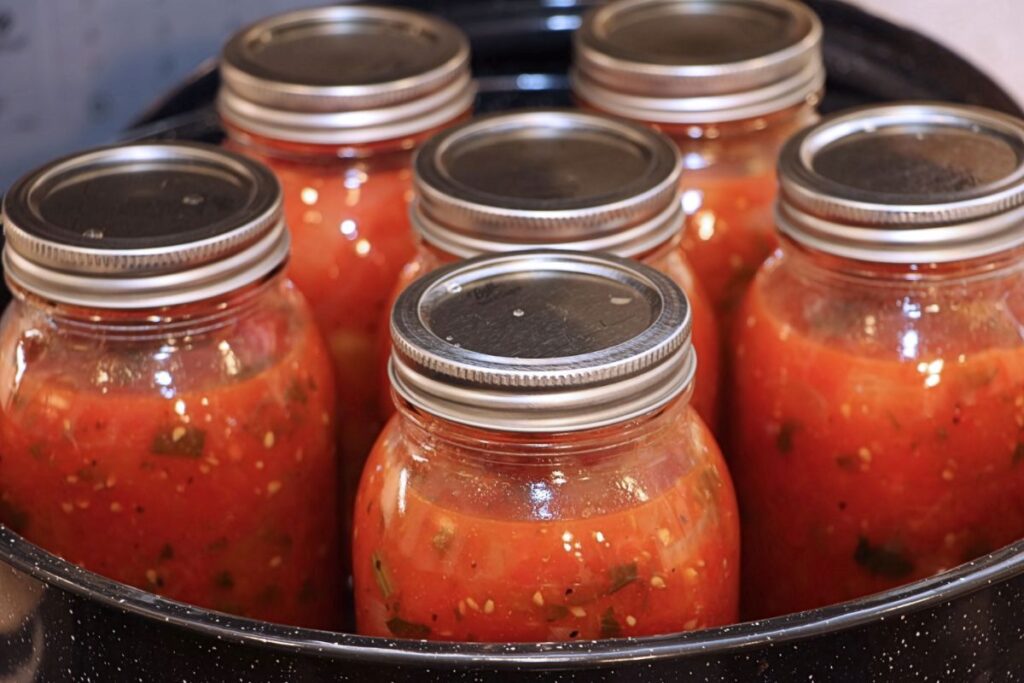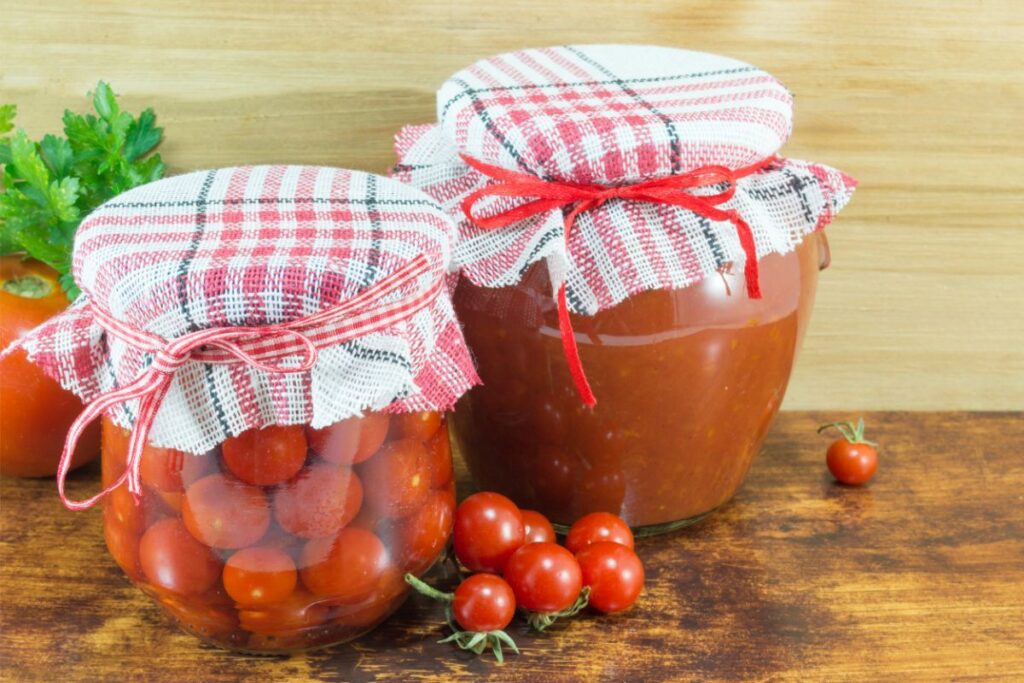If you are a novice homesteader left with an abundance of sun-kissed tomatoes, you might want to know about the kettle canning process to preserve their juicy goodness until the end of the winter season.
The open kettle method is a traditional approach for canning tomatoes and involves:
- Boiling the tomatoes
- Filling the sterilized jars and sealing them
- Relying on heat to preserve the content.
However, this method is no longer recommended because it does not meet safety standards.
In this article, I’ll explore the ins and outs of the open kettle process for canning tomatoes, and explain:
- What is the method for open kettle canning tomatoes?
- Why is the open kettle canning method not recommended for tomatoes?
- What is the safest way of open kettle canning for tomatoes?

What is the open kettle method of canning tomatoes?
The open kettle method is a traditional way to can tomatoes, and it’s a pretty straightforward process.
Here’s the deal. You boil the tomatoes first, pour them into sterilized jars, then apply the lids, and let the magic happen in 30-36 hours.
The heat of the jar, along with the boiling temperature of the tomatoes, creates a seal on the lid without any processing and preserves the contents inside.
My amigos! I’ll discuss this method in detail below, but there are some things you might consider before opting for the open kettle canning tomatoes method.
Why is open kettle canning not recommended?
The open kettle method was once used for preserving food items like pickles, jams, and jellies that could handle this treatment.
Back in the day, folks would also use this technique for canning tomatoes and applesauce too. But here’s the kicker: time has changed, and researchers do not recommend this approach now.
Why, you ask? Turns out this method does not meet the safety standards we follow today.
First up, the process does not provide enough heat to destroy harmful organisms like yeasts and mold that can find their way into the jars while filling them with tomatoes.
Moreover, this method does not seal the jars strong enough to create a vacuum and keep your food safe and sound for a long time.
Here’s another fact! Since some tomatoes have a lower acid level, open kettle canning can be especially risky because it creates the right environment for the growth of bacteria.
By now, you might have got the idea that if you want to safely preserve your tomatoes to enjoy their essence in the next seasons, this method won’t do the trick.

What is the safest method of open kettle canning?
If you still want to choose the open kettle canning method to preserve your tomatoes, let me share the safest way for you to do so.
Step 1: Peel and Slice the Tomatoes
First thing first, gather your fresh, ripe tomatoes, and spread them on a table to pluck away any rotten or damaged ones. Next up, put a large pot on the stove top, fill it with water, and bring it to a rolling boil at 212 °F.
TIP: You can check the water temperature using a kitchen thermometer.
Now put your tomatoes in the water and let them sit for about 1 minute. That should let their skin to swell up (a minute is normally plenty long enough).
Drain the water carefully and let the tomatoes cool down enough so you don’t burn your fingers. Finally, start peeling their skin off.
Wait a minute; there’s more to do! Remove the stem core and cut the tomatoes into small slices but make sure to capture every drop of the juice in a bowl (No waste).
This juice adds flavor and ensures your canned tomatoes stay rich in deliciousness.
Step 2: Simmer the Tomatoes
Once you’ve peeled and sliced the tomatoes, it’s time to simmer and prepare them for sealing in the jars later.
For this, place a large pot on the stovetop, put the tomatoes along with the juice you’ve collected in the previous step into it, and set the flame to simmer or low heat. Afterward, start stirring gently until the tomatoes move freely in the pot, and the juice will help prevent any sort of burning.
Now, add some salt (I add 2 tablespoons for a 14-quart pot of tomatoes), but avoid iodized one because it might introduce Clostridium bacterial growth that causes botulism.
Remember to stir well and let the tomatoes cook for 15 minutes, ensuring the flavors meld perfectly.
Step 3: Sterilize the Jars
Alright, fellow canny enthusiast, we’ve reached a crucial moment of the open kettle canning technique for your health: sterilizing the jars. This step ensures the content remains safe, delicious, and free from any spoilage.
To start things off, wash all the jars and their lids using hot, soapy water and then fully submerge them in boiling water in a large pot for about 10 minutes. This will bound to kill all the germs or bacteria that may have manifested in them earlier.
After their luxurious spa treatment, carefully remove the jars and lids from the boiling water and use a clean damp paper cloth to wipe any leftover droplets.
Step 4: Fill the Jars and Store
You have now reached the moment you’ve been waiting to complete the process!
This is the last step; put a canning funnel in the jars, take your spoon or measuring cup, and carefully scoop those delicious tomatoes from your pot.
Now, pour the boiled chunks into the jars to fill them, but leave about 1/2 inch of headspace at the top and use your small spoon to remove any entrapped air bubbles. This will make your tomatoes snuggly, nestled, and ready for flavor preservation.
Don’t stop there. Let’s keep things rolling. Use a damp non-woven cloth to gently clean the rim of each jar and seal the lid carefully. Then, flip over the jars, place them on an even surface, and wait 10-15 minutes for a satisfying “Click” sound for a firm seal.
Exercise some patience, amigos! Wait for 36 hours before moving the jars to storage. Finally, find a cool, dry place with a level surface for your canned tomatoes to rest comfortably for later use.
Wrapping Up!
There you have it! I’ve shared everything you need to know about the open kettle canning method to preserve your tomatoes.
The keynote to remember here is to prioritize safety when storing the tomatoes and explore other methods like the water bath or pressure canning for extra assurance in preserving and enjoying these delicious fruits year-round.

